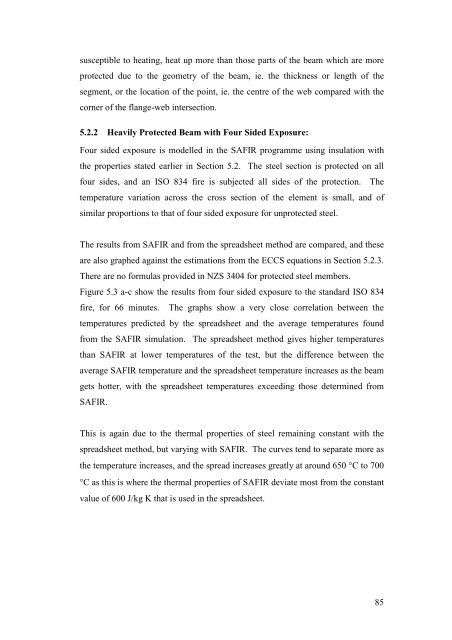FIRE DESIGN OF STEEL MEMBERS - Civil and Natural Resources ...
FIRE DESIGN OF STEEL MEMBERS - Civil and Natural Resources ...
FIRE DESIGN OF STEEL MEMBERS - Civil and Natural Resources ...
You also want an ePaper? Increase the reach of your titles
YUMPU automatically turns print PDFs into web optimized ePapers that Google loves.
susceptible to heating, heat up more than those parts of the beam which are more<br />
protected due to the geometry of the beam, ie. the thickness or length of the<br />
segment, or the location of the point, ie. the centre of the web compared with the<br />
corner of the flange-web intersection.<br />
5.2.2 Heavily Protected Beam with Four Sided Exposure:<br />
Four sided exposure is modelled in the SAFIR programme using insulation with<br />
the properties stated earlier in Section 5.2. The steel section is protected on all<br />
four sides, <strong>and</strong> an ISO 834 fire is subjected all sides of the protection. The<br />
temperature variation across the cross section of the element is small, <strong>and</strong> of<br />
similar proportions to that of four sided exposure for unprotected steel.<br />
The results from SAFIR <strong>and</strong> from the spreadsheet method are compared, <strong>and</strong> these<br />
are also graphed against the estimations from the ECCS equations in Section 5.2.3.<br />
There are no formulas provided in NZS 3404 for protected steel members.<br />
Figure 5.3 a-c show the results from four sided exposure to the st<strong>and</strong>ard ISO 834<br />
fire, for 66 minutes. The graphs show a very close correlation between the<br />
temperatures predicted by the spreadsheet <strong>and</strong> the average temperatures found<br />
from the SAFIR simulation. The spreadsheet method gives higher temperatures<br />
than SAFIR at lower temperatures of the test, but the difference between the<br />
average SAFIR temperature <strong>and</strong> the spreadsheet temperature increases as the beam<br />
gets hotter, with the spreadsheet temperatures exceeding those determined from<br />
SAFIR.<br />
This is again due to the thermal properties of steel remaining constant with the<br />
spreadsheet method, but varying with SAFIR. The curves tend to separate more as<br />
the temperature increases, <strong>and</strong> the spread increases greatly at around 650 °C to 700<br />
°C as this is where the thermal properties of SAFIR deviate most from the constant<br />
value of 600 J/kg K that is used in the spreadsheet.<br />
85
















